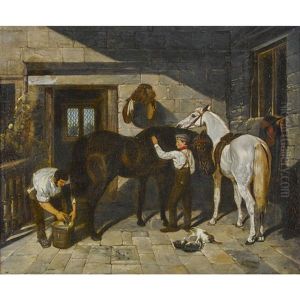Henry Hugh Armstead Paintings
Henry Hugh Armstead was a British sculptor and illustrator born on June 18, 1828, in London. He came from a family with artistic connections; his father was a jeweler and his uncle a sculptor. Armstead was educated at various art schools, including the Royal Academy Schools, where he excelled and began to establish a name for himself in the Victorian art world.
Throughout his career, Armstead was known for his versatility and skill in high-relief sculpture and metalwork. He contributed to the decorative arts movement of the 19th century and worked on a range of projects, from church monuments and public statues to intricate silverwork and book illustrations. One of his most notable contributions was to the design of the Albert Memorial in London, where he was responsible for some of the friezes that adorn the base, depicting poets and artisans.
Armstead's work was characterized by its intricate detail and historical accuracy, often inspired by literature and history. He was part of the Gothic Revival movement and was skilled in adapting his style to fit the architectural and decorative contexts of his commissions. This adaptability made him a favorite among the architects of the time, such as George Gilbert Scott. In addition to the Albert Memorial, Armstead worked on the ornamental designs for the Palace of Westminster and the Great Exhibition of 1851.
Aside from his sculptural work, Armstead also gained recognition for his illustrations, contributing to editions of works by notable authors like John Milton and Henry Wadsworth Longfellow. His engravings often accompanied texts in fine publications, thus expanding his influence beyond the realm of sculpture to the graphic arts.
Armstead was elected as an associate member of the Royal Academy in 1875 and became a full academician in 1879, reflecting his respected status in the British art community. He continued to work and exhibit at the Royal Academy throughout his life. Henry Hugh Armstead passed away on December 4, 1905, leaving behind a legacy of work that exemplified the detailed craftsmanship and aesthetic values of the Victorian era in British art.



